This forward movement and resulting increase in protrusiveness is one of three aspects of the malocclusion that often worsen during the initial phase of extraction treatment.
The second unfavorable side-effect that often occurs early in extraction cases is unwanted bite deepening. The canines often erupt in an upright position in crowded cases. If a light straight wire is placed into a canine bracket when the tooth is upright, placing that wire through the incisor brackets will cause over eruption of the incisors and hence bite deepening. This is contra-indicated in most cases.The figure below demonstrates how this happens.

Third,the molar relationship often drifts toward Class II early in these cases. This is how it happens.
When an archwire is tied in to all the brackets, friction between bracket and wire plus the elastic or steel ties make the entire arch behave as one unit. Since the upper anterior teeth have more total tip than the lower anterior teeth, the upper teeth will move anteriorly more than will the lower anteriors. As the uppers move forward, they drag the molars with them (Remember, friction makes the arch act as one unit. The anteriors and posteriors move together.) The lower anteriors, because they have less tip, don't advance as much as the uppers, so the lower molars don't advance as much as the uppers. As a result, the molar relationship moves toward Class II.
These undesirable movements can be minimized by using anchorage control, which is defined as the maneuvers used to restrict undesirable changes during the initial phase of treatment so that leveling and aligning is achieved without the key features of the malocclusion worsening.
Two maneuvers make up anchorage control. The first technique is called a bendback. To use a bendback, simply bend back the archwire distal to the last banded (or bonded) tooth. This keeps the amount of wire from molar to molar constant, which helps prevent the teeth from advancing.

The second, and more important anchorage control technique, is called a laceback. Lacebacks consist of .010 ligature wire tied in a figure 8 fashion around the bracket on the last bracketed tooth up to the canine. The figure below illustrates how a laceback is engaged.

Lacebacks are tied in before engaging the archwire.Tie in the laceback, then tie in the archwire over the laceback. Tighten the laceback so it exerts pressure on the canine. This pressure not only prevents the canine from tipping forward (which would increase protrusiveness and deepen the bite) but also encourages the canine to move distally against the periodontal ligament.This creates about 1mm of space in the quadrant where the laceback is used.This space is then used as the teeth are aligned and correctly tipped. Clinically, light nickel-titanium archwires are capable of correcting about 2mm of crowding per month. This is exactly the amount of space one laceback in each quadrant will create. The space,because it is close to the crowding, is available for relief of crowding. Clinically, the crowding is relieved by using this readily available space rather than the the teeth moving labially.

src="http://pagead2.googlesyndication.com/pagead/show_ads.js">
After the canine is moved distally, the laceback loses its tension. This gives the teeth a chance to move into the created space. When the patient returns for a 4 week recall, tighten the lacebacks. This will create another millimeter per side (2mm total), that will be used for aligning and tip control. The lacebacks are tightened at 4 week intervals until aligning is complete. When the patient is ready for a wire progression, the lacebacks can be removed.
The net effects of lacebacks are the use of the extraction sites to relieve crowding and to allow the expression of tip, discourage bite deepening, and prevent the molar relationship from becoming more ClassII.
Here is an example of a laceback.



Lacebacks not only inhibit forward canine movement, but they are an effective way of distalizing the canines. This occurs because the lacebacks tip the canines at the gingival aspect of the alveolar crest. Due to the leveling effect of the archwire,the tooth rebounds as the roots tip distally.(1) A study by S N Robinson of 57 extraction cases showed lacebacks result in a net distal movement of incisors during resolution of crowding. This movement averaged over 1mm (remember, crowding was also relieved).In extraction cases without lacebacks the incisors moved forward almost 2mm.
The bottom line is that lacebacks make additional molar support (headgear, TPA's, or lower molar anchorage) unnecessary in most cases. Six to seven mm of arch length discrepancy can be corrected using this technique.
Questions
1) If the force exerted by a laceback cause the canines to move distally, why don't the molars move mesially because of the reciprocal force?
Answer- Clinically, it has been found the molars just don't move forward. The force level provided by the laceback is not enough to affect the large molar teeth.
2) Why not just use a chain elastic? It sure is a lot easier to tie in a piece of chain instead of having to manipulate the long steel ligature tie.

Lacebacks are effective because they don't produce continual forces. The space is created, then they stop working until they are re-activated. This light, intermittent force is probably the reason the molars are unaffected. Also, the heavier forces produced by chain will cause teeth to tip into the extraction sites (see photo). Lacebacks do not cause this worsening of the malocclusion.
1. McLaughlin,RP and Bennett,JC:The transition from standard edgewise to pre-adjusted appliance systems, JCO. 23:142-145,1989.












